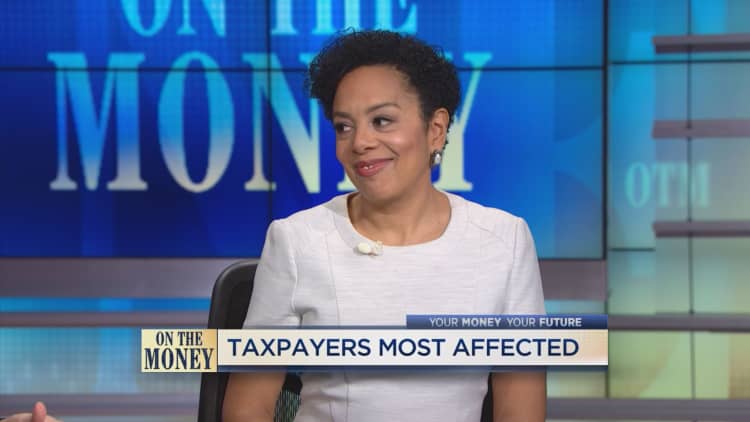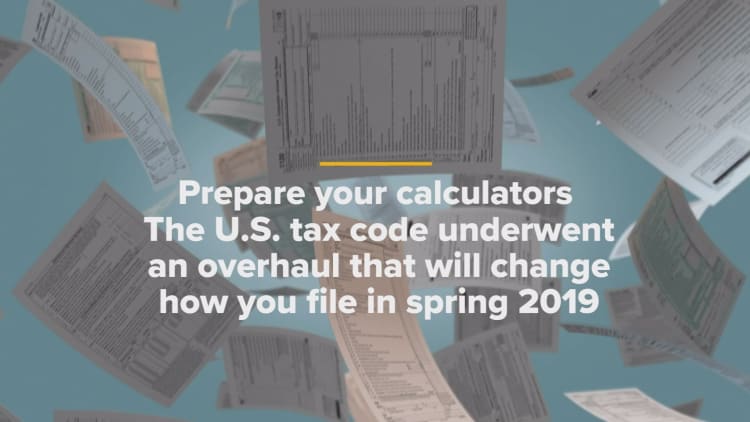
If you failed to withhold sufficient taxes from your pay in 2018, the IRS might grant you some forgiveness.
The tax agency said on Wednesday it would waive the penalty for taxpayers who paid at least 85 percent of their tax liability for 2018.
Normally, in order to avoid a penalty for underpayment, you have to pay at least 90 percent of what you owe for the tax year in question or 100 percent of the tax liability from the prior year (110 percent if your adjusted gross income on that year's return exceeded $150,000).
The IRS has been reminding taxpayers to review their W-4 throughout 2018, asking them to ensure that they are withholding sufficient taxes from their pay.
That's because the Treasury Department and the IRS updated their withholding tables to reflect the changes from the new Tax Cuts and Jobs Act. The overhaul of the tax code slashed individual income tax rates, doubled the standard deduction and eliminated personal exemptions.

"We realize there were many changes that affected people last year, and this penalty waiver will help taxpayers who inadvertently didn't have enough tax withheld," said IRS Commissioner Chuck Rettig.
"We urge people to check their withholding again this year to make sure they are having the right amount of tax withheld for 2019," he said.
You should also know that if you paid less than 85 percent of the liability owed — the minimum threshold for 2018 — you will still be on the hook for the penalty, said Gil Charney, director at The Tax Institute at H&R Block.
However, if you do qualify for the relief, you'll need to complete Form 2210, titled "Underpayment of Estimated Tax," and make note of the waiver on the form, Charney said.
For the new year, the IRS has bumped up the individual income tax brackets, adjusting them for inflation.
See below for your new bracket:
The withholding tables are guidelines your employer follows in order to deduct the appropriate amount of income taxes from your paycheck. You can also use your W-4 to tailor the taxes withheld from your pay.
If not enough is withheld, you'll owe money come tax time. Pay too much, and you end up with a large refund.
Nearly three-quarters of taxpayers withheld too much in 2018 and, as a result, will receive a refund this year. On the flipside, 21 percent of taxpayers — or about 30 million people — aren't withholding enough taxes, according to a report by the Government Accountability Office.
While getting a bigger paycheck each pay period sounds alluring, it could come back to bite you in the form of a hefty tax bill come April.
Alternatively, withhold too much and "you've essentially given the government a short-term loan," said Daniel Routh, a certified financial planner at Exencial Wealth Advisors in Oklahoma City.
"You may as well have that money in your bank account and save it, invest it or pay down debt," he said. "Ideally you want to come in as close to zero as possible."
Before 2019, it may have made sense to withhold less from your pay if you itemized deductions. That may no longer be the case now that the standard deduction has nearly doubled.
Because of the new tax law, many of those who itemized in the past will no longer be able to do so going forward — one reason to revisit your withholding.
Under the old law, it may have also made sense to withhold less in taxes if you had dependents. Now, personal and dependent exemptions are out, so these filers should review their pay stub to ensure that they're not under-withheld.
If you've retired, you can use Form W-4V to withhold a flat rate from your Social Security check or Form W-4P to withhold from your pension.
The IRS has a withholding calculator to help taxpayers figure out how much to have deducted from each paycheck and help you estimate your 2019 income and compare it to your current withholding. To get started, you'll need a copy of your most recent pay stub and tax return.
You can also cross-check that number with your CPA or tax preparer to make sure you are on the right track.
"On the Money" airs on CNBC Saturdays at 5:30 a.m. ET, or check listings for air times in local markets.
More from Personal Finance:
3 steps to keeping your resolutions to spend less, save more
Say good-bye to these tax deductions
More ways to save on your 2018 taxes

